20 Orchestral Violin Bowing Techniques | Violin Lounge TV #504
All types of bow strokes violinists use in an orchestra explained with beautiful examples and sheet music notation:
When you see an orchestra play you might be wondering what types of bow strokes, the different bowing techniques, the violinists can do.
Well… maybe you’re not wondering that at all, maybe it’s just me… I’m calling out all bow technique nerds to dive deep into orchestral bowing techniques.
Video content:
- 00:34 Detaché
- 01:22 Accented Detaché
- 01:53 Legato
- 02:33 Portato
- 03:04 Tremolo
- 04:46 Martelé
- 05:39 Staccato
- 06:12 Up Bow Staccato
- 06:41 Hooked Bowing
- 07:24 Collé
- 08:03 Brush Spiccato
- 08:47 Bounce Spiccato
- 09:43 Flying Spiccato
- 10:18 Sautillé
- 11:02 Ricochet
- 11:53 Pizz vs Arco
- 12:37 Col Legno
- 13:27 Sul ponticello
- 13:48 Sul Tasto
- 14:20 Staggered Bowing
#1 Detachè: Fast Articulated and Smooth/Slow
Detachè, played completely on the string, is by far the most common bow stroke. This is a legato bowstroke, but it can be played at any tempo with any amount of bow. Because detachè includes such a broad range of possiblities, we can further divide it into two main types: fast articulated detachè and smooth/slow detachè. The principle of both techniques is the same. The bow stays on the string, and the change of bow is what creates the articulation.
As this is the default way of bowing, there’s no particular symbol in the sheet music.
Fast articulated detaché

Smooth/slow detaché

#2 Accented Detachè
Accented detachè has a stronger articulation at the bow change, but each note is still legato. It is very similar to martelè (we’ll get to that later) but the notes are a little more connected. Also, accented detachè works for faster passages than martelè does because martelè requires more control.
Sometimes accented detaché is indicated by accent symbols in the sheet music like below, but often it derives from the musical context or performance tradition.

#3 Legato
Legato means playing multiple notes on one smooth bow stroke (slurred). The amount of bow used depends on the number and length of the notes in the slur. The important thing is that the same amount of bow be used on every note, and that the bow speed and placement (distance from the bridge) is consistent. This will keep an even, supported tone throughout. In the sheet music you’ll see slur above the notes.

#4 Portato
Portato is also several notes on one bow stroke. However, the bow is stopped between notes, but without an accent or bite. Portato creates a beautiful effect and is often used in Romantic Era orchestral literature. In the sheet music you’ll see a slur, but also lines above or below the notes.

#5 Tremolo: 3 Types
Tremolo is a fun and exciting technique that only appears in orchestra music. It is better to think of tremolo not as its own bowing, but rather as a very rapid detachè stroke. It should be played in the upper part of the bow, but the amount of bow depends on the volume and speed of the tremolo. There are three main types of tremolo: unmeasured, measured, and fingered.
All tremolo is notated by putting slashes through the beams of the notes. If there are three slashes through the stems, it means to play small detachè strokes as quickly as possible. This is unmeasured tremolo.
Measured tremolo means dividing a note into a specific number of shorter notes. For example, if you see one slash through a half note, it means play four eighth notes. Two slashes mean eight sixteenth notes. It gets a bit fuzzy with quarter notes: two slashes can either mean sixteenth notes or unmeasured tremolo. At that point, it depends on the musical context and ultimately the wish of the conductor.
Fingered tremolo sounds similar to a trill, but it is notated differently. The bow just plays one long note, but the fingers rapidly alternate between two notes. This creates a very shimmery, mysterious sound. Fingered tremolo can be measured or unmeasured. One very important tip is that you always play the two notes on the same string rather than trying to alternate between strings.
Unmeasured tremolo

Measured tremolo

Fingered tremolo

#6 Martelé
Martelé is very similar to detachè, except that it is not a legato technique. Set the bow firmly on the string with pressure from the index finger. Release the pressure the moment you move the bow. The goal is to get a full sound with a click or bite at the beginning. You must stop the bow very briefly to reinitiate the pressure before every martelé note. The notation of martelé is usually a dot above or below the note, an accent symbol and/or the text ‘marcato’.

#7 Staccato
Staccato is related to martelé but suitable for smaller, shorter notes. The bow must stop completely before and after every note. While martelé sounds best with quarter notes, staccato can be played at faster speeds. The sheet music notation is a dot below or above the note.

#8 Slurred Staccato
“Slurred staccato” can be a confusing term because it is not a legato stroke. It is also called linked staccato or upbow staccato. There are multiple notes on each upbow, but the bow is stopped after each one. This technique is often used in very fast passages. In the sheet music you see a slur above the notes and dots above or below the notes.

#9 Hooked Bowing
Hooked bowing is used to connect a series of uneven note values. For example, imagine a passage that has a repeated pattern of dotted quarters and eighths. You can try to play these all separate, but it will be difficult to stay in the same part of the bow. Hooked bowing maintains an even sound and comfortable bow position. One can indicate hooked bowing with a slur and a dot above or below the shorter note. However mostly this is more of a custom way of bowing that is not indicated in the sheet music.

#10 Collé
Collé is a very unique stroke because it begins on and ends off the string. It is also a wonderful exercise to improve finger flexibility. The bow is placed at the frog, and through the action of the fingers scrubs the string and lifts off. Collé can be done in other parts of the bow, but it is most common and easiest at the frog. The right hand fingers are rounded when initiating a downbow stroke and straight when initiating an upbow. Another way to think of colle is “pizzicato with the bow.”

#11 Brush Spiccato
Brush spiccato looks like detachè, but you do use the bounce of the bow rather than leaving it on the string completely. It is a broad spiccato in the lower half, and is slower than other types of spiccato. Brush spiccato is an active bow stroke (meaning the right hand/arm actively controls the bounce). The sheet music notation can be eight notes or faster notes with dots below or above them, but usually it’s not indicated and you know from the historical or musical context that you should play it.
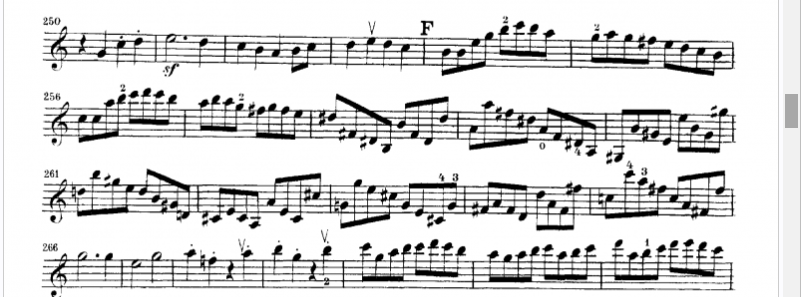
#12 Bounce Spiccato
Bounce spiccato works best in the middle of the bow. Generally, the faster the spiccato the higher in the bow you should play. It is easier to play faster higher up the bow, and the height of the bounce also affects the speed. Bounced spiccato strokes are less broad than brushed ones.
Bounce spiccato works at a variety of tempos, so just keep in mind that the faster you go, the more the bounce of the bow takes care of itself. You will reach a point at which the right hand stays completely relaxed while the bow rebounds on its own. This comes from the right combination of bow placement, speed, angle, and height of the bounce.
In the sheet music you’ll mostly see dots below or above the notes, but know that this dot can also mean staccato for example. It depends on the musical and historical context, which bowing technique should be applied.
Fast spiccato

Slower bounce spiccato (more active bow technique)
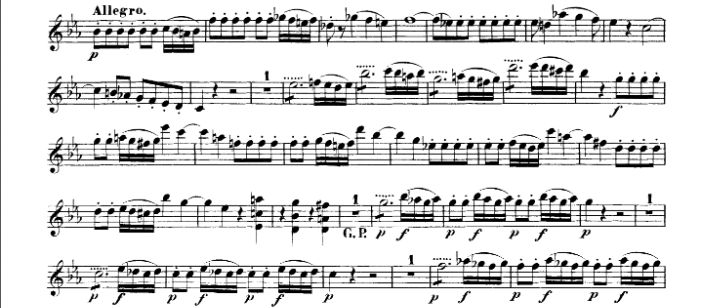
#13 Flying Spiccato
Flying spiccato is similar to upbow staccato, but the bow leaves the string after each note. This stroke is done using the lower two thirds of the bow as it is too difficult to control in the upper third. When playing in an orchestra, the first upbow stroke is done collé for ensemble purposes. Long flying spiccato scales sometimes appear in violin solo music, but for orchestra the flying spiccato passages are usually two to four notes long.

#14 Sautillé
Sautillé is essentially spiccato at a faster tempo. As stated above, it is done a little higher in the bow (slightly below the middle). In fact, sautillé is so fast that the hair does not actually leave the string, it is just the stick that is springing. The bow moves in small, very rapid up and down strokes while vertical pressure is applied by the hand and arm.
In the sheet music you’ll usually see sixteenth notes with dots above or below the notes.
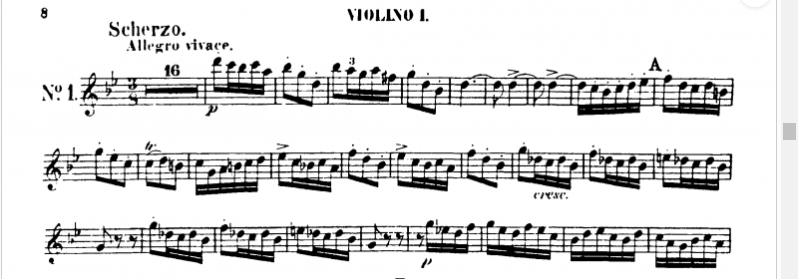
#15 Ricochet (Saltando)
Ricochet is the only bow stroke that starts off the string. It is a passive stroke and the bow bounces naturally after being dropped onto the string. In orchestral music, ricochet often appears as three fast downbows followed by an upbow that is lifted off after the note. This works best in the upper third of the bow.
In the sheet music you’ll see several notes on a down bow with a slur and dots below or above followed by an up bow that usually has a longer note value.
The video can’t be embedded, but can be found here.

#16 Pizzicato vs Arco
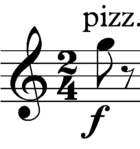 It doesn’t quite make sense to call this a “bow technique” since it doesn’t use the bow at all! Nevertheless, it is very important for orchestra players to understand this term.
It doesn’t quite make sense to call this a “bow technique” since it doesn’t use the bow at all! Nevertheless, it is very important for orchestra players to understand this term.
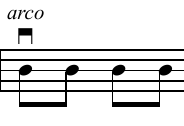 Pizzicato is when you pluck the string with your right hand instead of playing it with the bow.
Pizzicato is when you pluck the string with your right hand instead of playing it with the bow.
In the sheet music ‘pizz’ will be indicated. When you see arco, that is the signal to start using the bow again.
#17 Col Legno
Col legno is a very fun and unusual technique where you use the wood of the bow to create a special sound effect. There are two types: battuto and arco. In the sheet music the type is usually written in. ‘Col legno’ means the most common battuto type. Battuto simply involves dropping the stick onto the string percussively. The violin part in the opening of Holst’s Mars is an excellent example. Alternatively, composers sometimes ask for col legno arco, where the sound is created half with the hair and half with the wood while doing detachè. It is not a common technique, but very fun when you do get to do it!

#18 Sul Ponticello
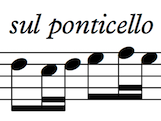 Sul ponticello literally means “on the bridge”. Please don’t take this literally as you will be very disappointed with the result. It just means to play as close to the bridge as possible which produces a glassy, transparent sound. It is meant to have a very different tone quality, but the trick is not to use too much pressure and squash it. In the sheet music usually it’s indicated by the text ‘sul ponticello’.
Sul ponticello literally means “on the bridge”. Please don’t take this literally as you will be very disappointed with the result. It just means to play as close to the bridge as possible which produces a glassy, transparent sound. It is meant to have a very different tone quality, but the trick is not to use too much pressure and squash it. In the sheet music usually it’s indicated by the text ‘sul ponticello’.
#19 Sul Tasto (Flautando)
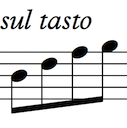 This is the exact opposite effect: “on the fingerboard”. This is frequently used by 20th-century composers for very soft, mysterious passages. It can also be used whenever an extremely soft dynamic is needed, since the fingerboard mutes the sound.
This is the exact opposite effect: “on the fingerboard”. This is frequently used by 20th-century composers for very soft, mysterious passages. It can also be used whenever an extremely soft dynamic is needed, since the fingerboard mutes the sound.
#20 Staggered Bowing
One of the most important things to realize as orchestral string players is that it is not necessary to play super long notes all in one bow. Often composers will even indicate that they want players to change bow at different times during the long note to keep the sound sustained. This is called staggered bowing, and it will come in handy more often than you realize.
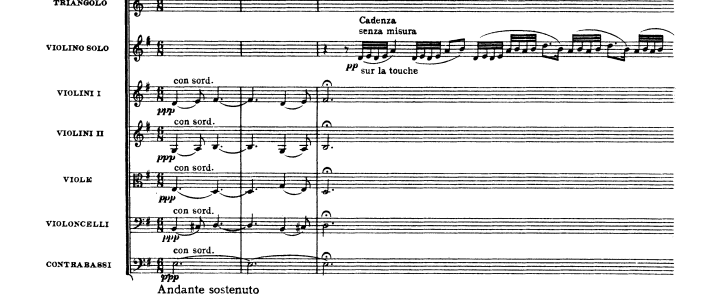
Improve your violin bowing technique
Enjoy my FREE mini Masterclass 5 Bowing Secrets to Create a Professional Sound on the Violin

Hi! I'm Zlata
Classical violinist helping you overcome technical struggles and play with feeling by improving your bow technique.
I hope you enjoyed exploring the types of bow techniques orchestra violinists need to master!
If you’re curious about all possible bowing techniques and sound effects on the violin, watch my video with 102 violin bowing techniques right here.
The basis of all bowing techniques is that you have a proper bow hold and know the right movements in your arm, wrist and fingers while bowing. Watch this video about bowing smoothly to learn more.
Do you want my help in improving your violin bowing technique? As a violin teacher and bowing coach I have two great opportunities for you to learn with me:
The Violin Bowing Bootcamp is a short affordable course that will teach you the basics of violin bowing and the most common bow strokes.
Bow like a Pro is the masterclass program in which you really learn everything bowing and can also get feedback on your playing.
Which violin bow stroke is your favorite?
Leave a comment below!


Because of bow techniques violin is difficult to play
Yes, it does take dedication, but is all learnable.